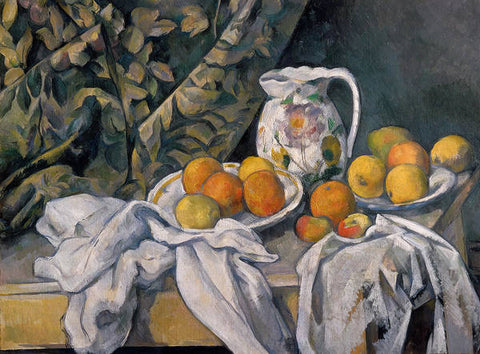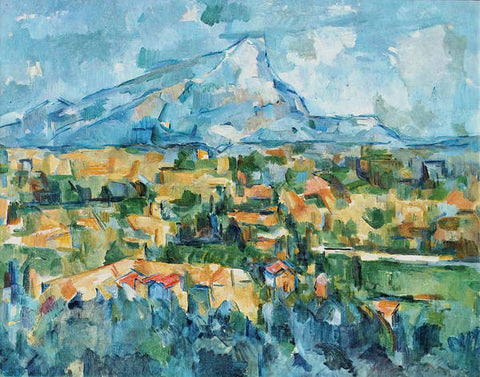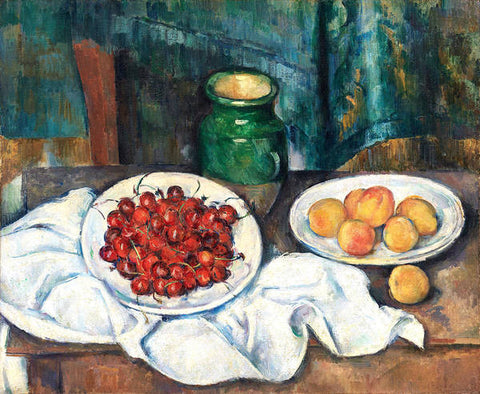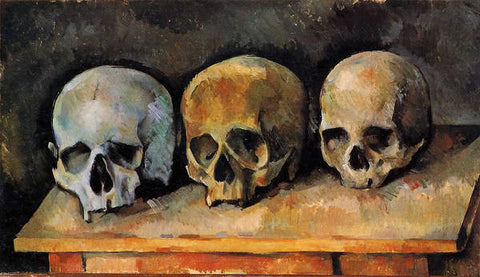Introduction:
In the annals of art history, the name Paul Cézanne stands as a beacon of innovation and a pioneer in the realm of post-impressionist art. His revolutionary approach to form and colour paved the way for modern art movements, influencing generations of artists. In this exploration, we delve into the top ten most popular artworks by Paul Cézanne, unravelling the brilliance and enduring significance of each masterpiece.
Is a captivating landscape painting that captures the essence of Montagne Sainte-Victoire, a prominent mountain near Aix-en-Provence in southern France. Created by Cézanne around 1887, this artwork features the distinctive form of the mountain and a towering pine tree in the foreground.
In this masterpiece, Cézanne employs his revolutionary post-impressionist style, using bold brushstrokes and a unique color palette to convey the rugged terrain of the mountain and the lush foliage of the pine tree. The large pine tree dominates the foreground, its branches reaching skyward in a dramatic dance of form and shadow.
Cézanne's meticulous attention to detail is evident in the way he captures the play of light on the mountain slopes and the intricate interplay of colors within the pine branches. The painting is a testament to Cézanne's deep connection to the landscape and his ability to translate the natural world into a visual language that transcends mere representation.
"Ste-Victoire Mountain with Large Pine" is celebrated for its harmonious blend of structure and emotion, offering viewers a contemplative glimpse into Cézanne's profound appreciation for the beauty of the Provençal landscape. The artwork stands as a timeless tribute to the artist's innovative vision and his transformative impact on the course of art history.
Is a vibrant and meticulously crafted composition that exemplifies the artist's mastery of still life. Painted around 1885-1887, this artwork showcases a table laden with luscious cherries and ripe peaches, arranged in a carefully considered manner.
Cézanne's distinctive post-impressionist style is evident in the use of geometric shapes and bold, visible brushstrokes that characterize the fruits and surrounding elements. The colours, ranging from deep reds of the cherries to the warm hues of the peaches, are rendered with a harmonious balance that captures the play of light and shadow.
What sets this still life apart is Cézanne's transformative approach to the genre. Rather than merely replicating the objects before him, he imparts a sense of depth and volume through his unique interpretation of form. The table and background are treated with the same attention to detail, creating a dynamic composition where every element plays a role in the overall visual harmony.
"Still Life with Cherries and Peaches" is a testament to Cézanne's innovative vision, transforming everyday subjects into a visual symphony of colour, shape, and texture. This artwork exemplifies the artist's profound influence on the still life genre, setting the stage for future generations of artists to explore the complexities and nuances of ordinary objects.

Created around 1899, is a captivating still life that showcases the artist's distinctive post-impressionist style. Translating to "Still Life with Curtain and Flowered Pitcher" in English, this artwork features a carefully arranged composition of everyday objects.
The centrepiece of the composition is a flowered pitcher, elegantly adorned with blooms. The curtain, draped in the background, adds a touch of theatricality to the scene. Cézanne's characteristic approach to form is evident in the geometric precision with which he renders the objects, using visible brushstrokes to create a dynamic interplay of light and shadow.
The subdued colour palette, featuring earthy tones and muted hues, contributes to the overall sense of harmony in the composition. Cézanne's meticulous attention to detail extends to the surrounding elements, such as the curtain folds and the tabletop, reflecting his commitment to capturing the essence of the scene with precision and depth.
"Nature morte avec rideau et pichet fleuri" exemplifies Cézanne's transformative approach to still life, elevating ordinary objects to subjects of profound artistic exploration. The painting stands as a testament to Cézanne's influence on the evolution of modern art, where the artist's innovative vision paved the way for new perspectives on form, colour, and the representation of everyday life.
Painted between 1888 and 1889, is a striking example of the artist's innovative approach to still life. In this composition, Cézanne arranges a collection of objects on a tabletop, featuring a prominent bottle of liqueur as the focal point.
The painting showcases Cézanne's post-impressionist style, characterized by bold brushstrokes, distinctive geometric forms, and a unique treatment of light and color. The bottle of liqueur, positioned centrally, draws attention with its bold and simple shape, while other objects such as fruit and a cloth contribute to the overall balance of the composition.
Cézanne's meticulous attention to detail is evident in the way he captures the reflective surfaces of the bottle and the textural qualities of the surrounding elements. The color palette is rich and harmonious, with warm tones that enhance the depth and three-dimensionality of the objects.
"Still Life with Bottle of Liqueur" exemplifies Cézanne's ability to transform ordinary subjects into complex studies of form and color. The painting invites viewers to appreciate the beauty in everyday items through the artist's unique lens, showcasing his enduring impact on the evolution of modern art.
Painted around 1900, is a haunting yet compelling exploration of the still-life genre. In this work, Cézanne presents three skulls arranged on a table, challenging traditional notions of beauty and the representation of mortality.
The composition is marked by Cézanne's post-impressionist style, characterized by distinct brushstrokes and a meticulous attention to form. The skulls, placed with a deliberate sense of geometry, command attention through their stark and skeletal presence. The interplay of light and shadow adds a dramatic dimension to the scene, enhancing the eerie atmosphere of the artwork.
Cézanne's choice of subject matter reflects a departure from conventional still-life subjects, pushing the boundaries of artistic expression. The neutral colour palette, dominated by muted tones, contributes to the overall somber mood of the painting.
"Still Life, Three Skulls" is a testament to Cézanne's willingness to explore the darker facets of existence and his ability to infuse even the macabre with a sense of aesthetic beauty. This artwork stands as a unique and thought-provoking example of Cézanne's late-career experimentation and his profound impact on the trajectory of modern art.
Conclusion:
Paul Cézanne's contributions to the world of art are immeasurable, and his legacy continues to resonate with artists and enthusiasts alike. Through these ten masterpieces, we witness the evolution of Cézanne's style, from his early explorations of form and light to his later, more abstract compositions. Each artwork serves as a window into the mind of a revolutionary artist who challenged the norms of his time, leaving an indelible mark on the course of art history. As we explore these timeless creations, we find ourselves immersed in the brilliance of Cézanne's vision—a vision that transcends the boundaries of time and continues to inspire and captivate the world.













